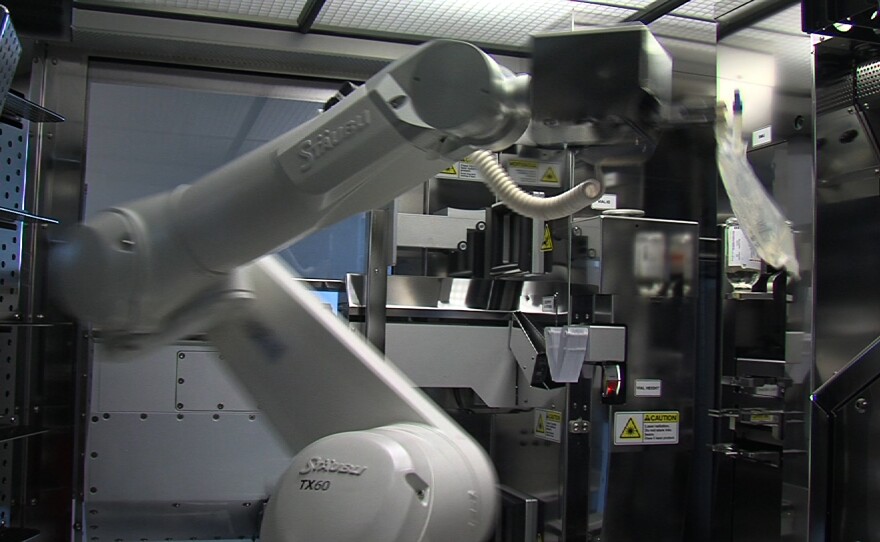Everyone makes mistakes. But mistakes made in a medical setting can kill. That’s why hospitals are stepping up their efforts to make sure patients aren’t given the wrong medication, or even worse, a contaminated drug.
San Diego County’s newest hospital is pulling out all the stops to try to prevent these kinds of medical errors.
People who work at Escondido’s Palomar Medical Center don’t wake up in the morning and decide to give someone the wrong drug.
But no one’s perfect.
That’s why Dr. Ben Kanter, Palomar's chief medical information officer, said Palomar computerizes the prescription drug process as much as possible.
“To ensure that when the doctor orders it, they’re ordering the right dosage for the right patient," Kanter explained. "And then when the nurse gets to the point of giving the medication, the medications are all bar-coded. So the nurse knows when they pick it up, and the nurse bar codes her own badge, bar codes the patient, bar codes the medication, the system says, 'yeah, this is the right medication, for that patient, to be given at this time, nothing’s changed. You’ve got a green light, you’re ready to go.'”
Kanter said it all starts with a doctor ordering the correct drugs. The computer is key to making sure there are no mistakes in that crucial first step.
“So let’s say you came in with something common, like pneumonia," Kanter said. "There are standards that every patient who has pneumonia around the United States should be treated in certain ways. We’ve built those into the system, so that when I order pneumonia, a pneumonia power plan for you, it’s got all of the standard antibiotics, as they’re supposed to be prescribed for you, all the tests that need to be done.”
The computer isn’t supposed to allow a doctor to order the wrong medication, or the wrong dose.

But as Kanter pointed to a computer screen, he said it could happen.
"And if I meant to click this square and I click this one instead, I’m going to have the wrong medication potentially picked. However, there’s a check on that, that I can’t sign this without again reviewing everything,” he said.
There’s another check built into the system in Palomar’s in-house pharmacy, said Dr. Cedric Terrell, the director of pharmacy services.
“When orders are placed in our computer system, from physicians, our pharmacist reviews those orders," Dr. Terrell pointed out. "They say, yep, it’s an appropriate order for this patient based on their age, weight, their allergy information, if they have any clinical conditions, it’s the appropriate drug for them, then that populates to our box picker.”
The box picker is basically a warehouse for most of the drugs used in the hospital.
Once an order is approved, the box picker dispenses it. A technician prepares the order, and a pharmacist checks it again. Only then is it distributed to the patient floor.
Most of the drugs Palomar uses are mass-produced by drug companies. But when a doctor wants an antibiotic added to an IV, or a special mix of drugs for a surgical patient, pharmacists have to make it themselves.
That adds another level of risk.
Take the recent case of a specialty pharmacy in Massachusetts, New England Compounding Center, that evidently didn’t pay enough attention to sterile practices.
It’s accused of making and distributing contaminated steroid injections earlier this year. The tainted medicine killed 36 people and sickened more than 500 in 18 states.
Palomar Hospital custom-makes about 500 medications a day. This compounding is done in a special area with restricted access, specially filtered air and extra levels of sterility.

To further reduce the possibility of contamination or human error, the hospital uses a robot called RIVA to mix and prepare IV medications. It’s a self-contained, sterile compounding machine.
Terrell explained the hospital uses RIVA to make large quantities of IV products.
“We can set it to run certain batches of products, that we know that we’ll use on a routine basis for our patients, and then we can free up our technicians to prepare ready-needed products for our patients, ” he said.
The robot allows Palomar to compound more of its own medications, thus reducing the need to buy from specialty vendors. This kind of control helps enhance safety.
But all of Palomar’s preparations mean little if nurses make a mistake at the end of the process.
Upstairs on one of the patient floors, advanced clinical nurse Pam White gets some medication for a man who has high blood pressure.
Before she can give it to him, she has to scan his bracelet, and scan the barcode on the drug.
White said all of the safeguards make sense.
“They’re great. We didn’t like ‘em at first, ‘cause it was so much of a hassle, but you know, they’re wonderful. No mistakes,” White said.
Palomar nurses distribute about 6,000 medications a day.






